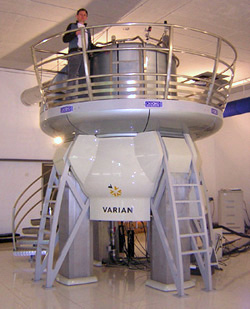Nuclear magnetic resonance spectroscopy

Nuclear Magnetic Resonance Spectroscopy (NMR Spectroscopy) is an analytical chemistry technique used in quality control and research for determining the content and purity of a sample as well as its molecular structure. NMR spectroscopy exploits the magnetic properties of certain atomic nuclei. A sample is placed in a magnetic field, and the NMR signal is produced by the excitation of the nuclei sample by radio waves into nuclear magnetic resonance, which is detected with sensitive radio receivers.
Principles of NMR Spectroscopy[edit]
The principle behind NMR comes from the magnetic properties of certain nuclei. Nuclei such as 1H, 13C, 15N, and 31P have a spin and, when placed in a magnetic field, exhibit magnetic moments that can align with or against the direction of the field. The application of a radio frequency (RF) pulse that matches the Larmor frequency of the nuclei causes them to flip their spin orientation. When the RF pulse is turned off, the nuclei return to their original alignment, emitting a radio wave that is detected and transformed into an NMR spectrum.
Types of NMR Spectroscopy[edit]
There are several types of NMR spectroscopy, each providing different kinds of information about the molecules being studied:
- 1H NMR Spectroscopy focuses on the hydrogen-1 nucleus and is widely used for the determination of molecular structure and conformation.
- 13C NMR Spectroscopy provides information about the carbon skeleton of organic compounds.
- Solid-state NMR Spectroscopy is used for studying materials in a solid phase, providing detailed information about structure, dynamics, and environment.
- Two-dimensional NMR Spectroscopy (2D NMR) offers detailed information about the molecular structure by correlating nuclei based on their interactions.
Applications of NMR Spectroscopy[edit]
NMR spectroscopy has a wide range of applications in various fields such as:
- Chemistry: For structural determination, identification of compounds, and analysis of complex mixtures.
- Biochemistry: For studying proteins, nucleic acids, and other biomolecules, including their structure, dynamics, and interactions.
- Pharmaceuticals: In drug discovery and quality control, to determine the purity and composition of drug products.
- Food science: For analyzing food content, quality, and authenticity.
- Materials science: For characterizing materials and studying their properties at the molecular level.
Advantages and Limitations[edit]
NMR spectroscopy offers several advantages, including the non-destructive nature of the analysis, the ability to provide detailed information about molecular structure and dynamics, and its applicability to a wide range of samples. However, it also has limitations, such as relatively high cost, the need for large sample amounts (compared to other spectroscopic techniques), and complexity in interpretation of the results.
See Also[edit]
Ad. Transform your life with W8MD's Budget GLP-1 injections from $75


W8MD offers a medical weight loss program to lose weight in Philadelphia. Our physician-supervised medical weight loss provides:
- Weight loss injections in NYC (generic and brand names):
- Zepbound / Mounjaro, Wegovy / Ozempic, Saxenda
- Most insurances accepted or discounted self-pay rates. We will obtain insurance prior authorizations if needed.
- Generic GLP1 weight loss injections from $75 for the starting dose.
- Also offer prescription weight loss medications including Phentermine, Qsymia, Diethylpropion, Contrave etc.
NYC weight loss doctor appointmentsNYC weight loss doctor appointments
Start your NYC weight loss journey today at our NYC medical weight loss and Philadelphia medical weight loss clinics.
- Call 718-946-5500 to lose weight in NYC or for medical weight loss in Philadelphia 215-676-2334.
- Tags:NYC medical weight loss, Philadelphia lose weight Zepbound NYC, Budget GLP1 weight loss injections, Wegovy Philadelphia, Wegovy NYC, Philadelphia medical weight loss, Brookly weight loss and Wegovy NYC
|
WikiMD's Wellness Encyclopedia |
| Let Food Be Thy Medicine Medicine Thy Food - Hippocrates |
Medical Disclaimer: WikiMD is not a substitute for professional medical advice. The information on WikiMD is provided as an information resource only, may be incorrect, outdated or misleading, and is not to be used or relied on for any diagnostic or treatment purposes. Please consult your health care provider before making any healthcare decisions or for guidance about a specific medical condition. WikiMD expressly disclaims responsibility, and shall have no liability, for any damages, loss, injury, or liability whatsoever suffered as a result of your reliance on the information contained in this site. By visiting this site you agree to the foregoing terms and conditions, which may from time to time be changed or supplemented by WikiMD. If you do not agree to the foregoing terms and conditions, you should not enter or use this site. See full disclaimer.
Credits:Most images are courtesy of Wikimedia commons, and templates, categories Wikipedia, licensed under CC BY SA or similar.
Translate this page: - East Asian
中文,
日本,
한국어,
South Asian
हिन्दी,
தமிழ்,
తెలుగు,
Urdu,
ಕನ್ನಡ,
Southeast Asian
Indonesian,
Vietnamese,
Thai,
မြန်မာဘာသာ,
বাংলা
European
español,
Deutsch,
français,
Greek,
português do Brasil,
polski,
română,
русский,
Nederlands,
norsk,
svenska,
suomi,
Italian
Middle Eastern & African
عربى,
Turkish,
Persian,
Hebrew,
Afrikaans,
isiZulu,
Kiswahili,
Other
Bulgarian,
Hungarian,
Czech,
Swedish,
മലയാളം,
मराठी,
ਪੰਜਾਬੀ,
ગુજરાતી,
Portuguese,
Ukrainian
